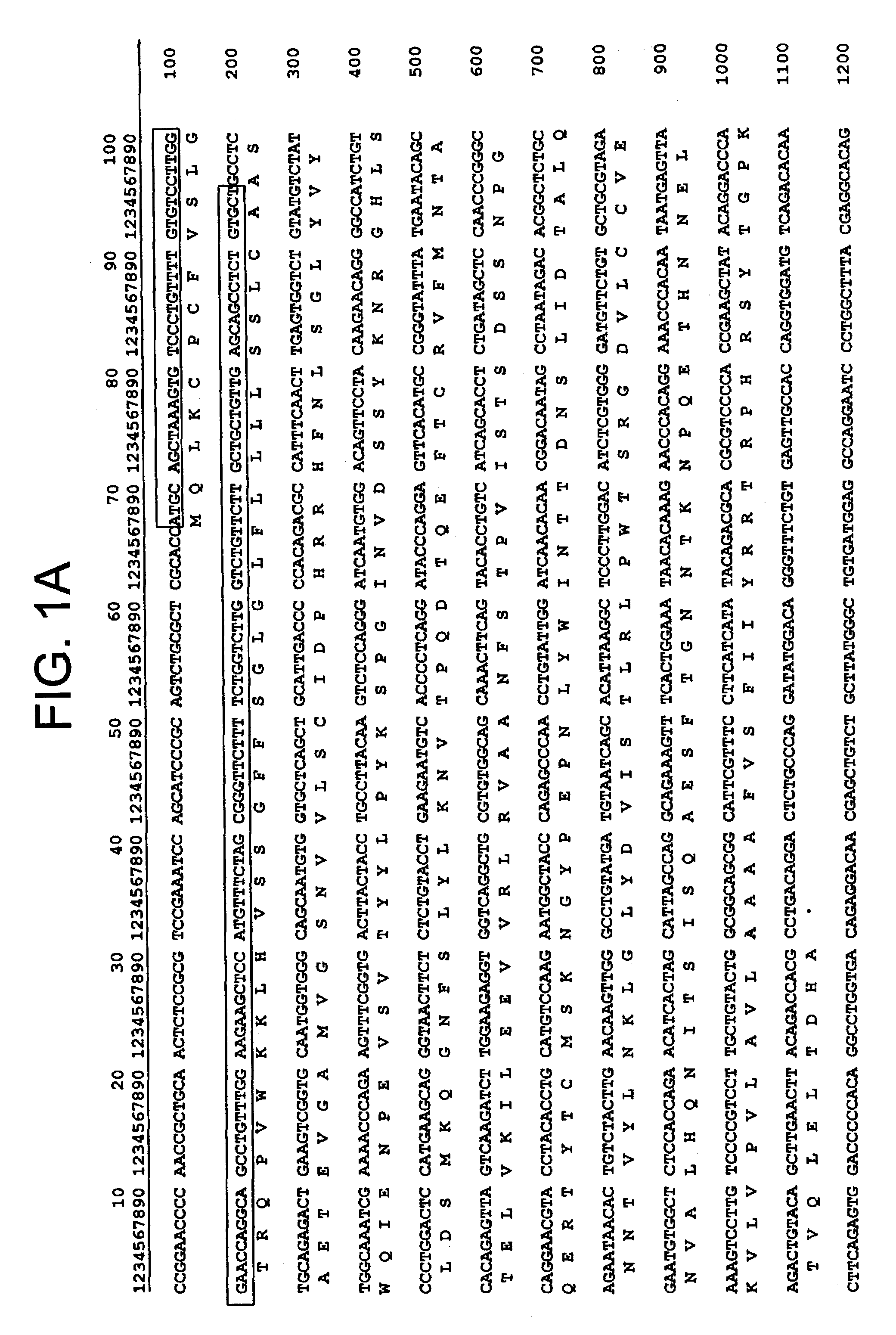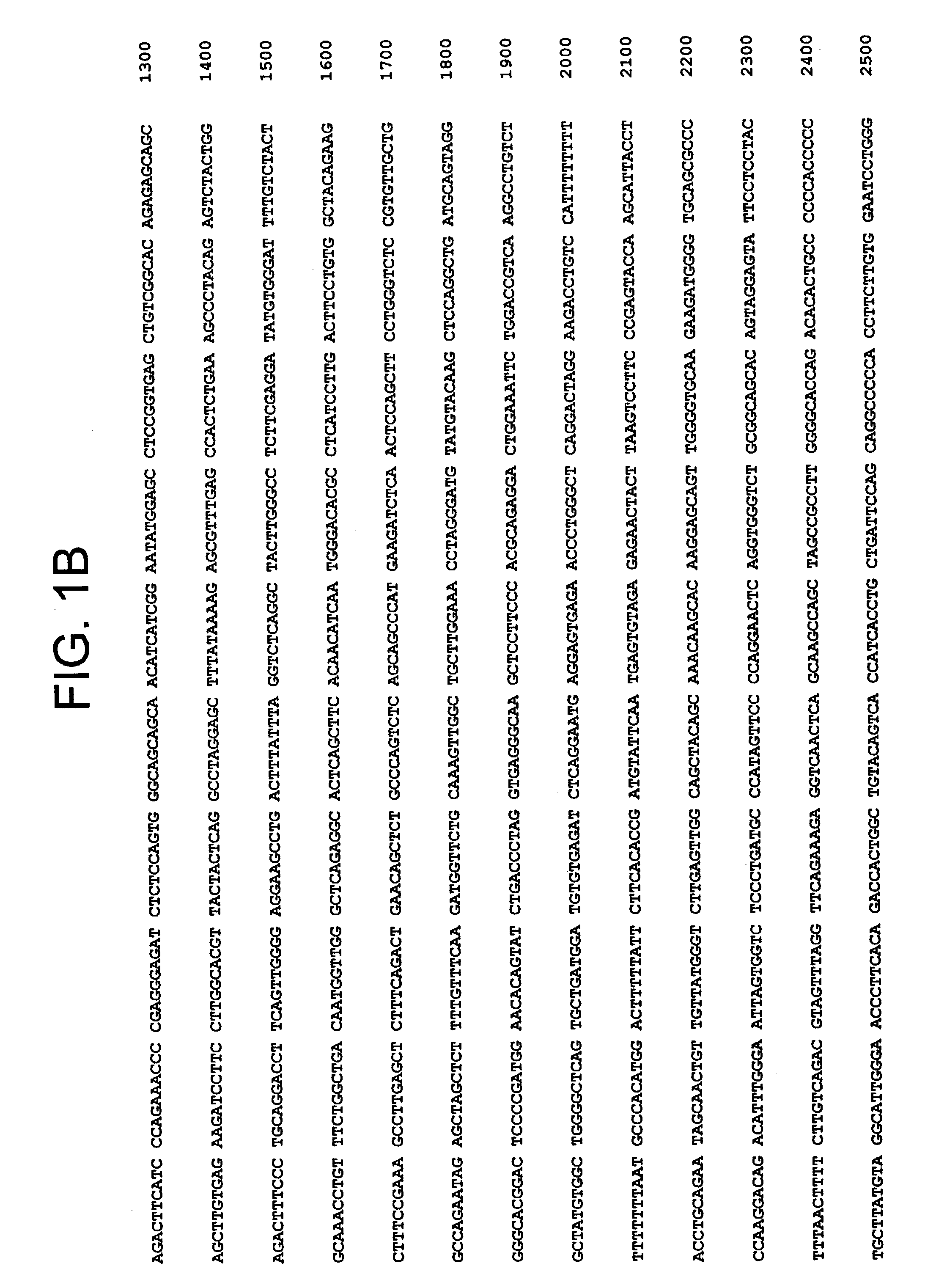GL50 polypeptides
a polypeptide and polypeptide technology, applied in the field of gl50 polypeptides, can solve the problems of controversial reports of the existence of additional members of the b7 costimulatory family, and achieve the effects of reducing the proliferation of tumor cells, reducing tumor cell proliferation, and enhancing the immune response to tumor cells
- Summary
- Abstract
- Description
- Claims
- Application Information
AI Technical Summary
Benefits of technology
Problems solved by technology
Method used
Image
Examples
example 1
Isolation of mGL50-1 Molecules
[0374]cDNAs encoding secreted proteins derived from RNA of IL-12 treated mouse lymph nodes were placed under genetic selection for signal sequences by using the Saccharomyces cerevisiae signal sequence trap method (Jacobs et al). Of a total of 333 cDNA:invertase clones isolated and sequenced, 1 partial cDNA clone with limited sequence identity with B7-1 was identified and termed mGL50-1 (FIG. 1, SEQ ID NO: 1). RecA mediated full length cDNA isolation from a mouse fetal thymus cDNA library resulted in the generation of 4 additional cDNA clones that contained 3′ untranslated regions as well as overlapping the partial signal trapped sequence clone.
[0375]The consensus 2718 nucleotide mGL50-1 sequence encoded a 322 amino acid protein with a predicted mass of 36 kDa. Hydropathy plot of the open reading frame predicted a structure corresponding to a leader sequence (from about amino acids 1-46 of SEQ ID NO: 2; encoded by about nucleotides 67 to 195 of SEQ ID N...
example 2
Isolation of an Alternatively Spliced Form of GL50
[0376]To determine the extent of transcript heterogeneity, 3′ RACE was performed to isolate splice variants of murine GL50-1. Using specific, nested 5′ oligonucleotide primers corresponding to sequences upstream and including the initiation start site of mGL50-1, amplified PCR products were generated from cDNAs derived from mouse PBLs. Upon hybridization to radiolabeled oligonucleotides internal to mGL50-1 coding region, clear hybridization signals were detected. Subsequent cloning of positively hybridizing PCR products followed by sequence analysis revealed RACE sequences of which none were identical to the consensus mGL50-1 sequence derived from the mouse fetal thymus library. Two sets of PCR products, represented by multiple clones with extensive polyadenylation of differing lengths, were found to encode an alternatively spliced form of GL50. One representative product, a 1759 bp product, termed mGL50-2, encoded a polypeptide 347 ...
example 3
Identification of a Human Ortholog of GL50
[0378]After the murine GL50 clones were identified, database search and subsequent comparisons suggested that mouse mGL50-1 and mGL50-2 clones may have homology with a cDNA isolated from human brain, KIAA clone 0653 (accession # AB014553; Ishikawa et al. (1998)DNA Res. 5:169). AB014553 has been described as a 4.3 kb cDNA localized on chromosome 21, encoding a putative 558 amino acid protein with a molecular mass of 60 kDa. Because both the length of the AB014553 cDNA and the encoded protein were nearly 2 fold greater than mGL50-1, it was not likely that AB014553 was a human ortholog of the mouse GL50 sequences. However, analysis of the first 303 residues of the deduced AB014553 protein sequence indicated similarity with mGL50-1, excluding the signal peptide region of the cDNA.
[0379]Because AB014553 was derived by size fractionation of large cDNAs, AB014553 was believed to represent a variant transcript that also existed as a smaller gene pro...
PUM
| Property | Measurement | Unit |
|---|---|---|
| mass | aaaaa | aaaaa |
| temperatures | aaaaa | aaaaa |
| molecular mass | aaaaa | aaaaa |
Abstract
Description
Claims
Application Information
 Login to View More
Login to View More - R&D
- Intellectual Property
- Life Sciences
- Materials
- Tech Scout
- Unparalleled Data Quality
- Higher Quality Content
- 60% Fewer Hallucinations
Browse by: Latest US Patents, China's latest patents, Technical Efficacy Thesaurus, Application Domain, Technology Topic, Popular Technical Reports.
© 2025 PatSnap. All rights reserved.Legal|Privacy policy|Modern Slavery Act Transparency Statement|Sitemap|About US| Contact US: help@patsnap.com



